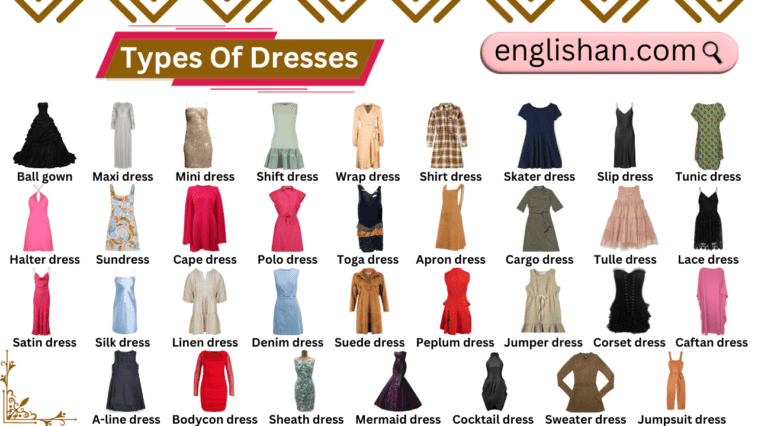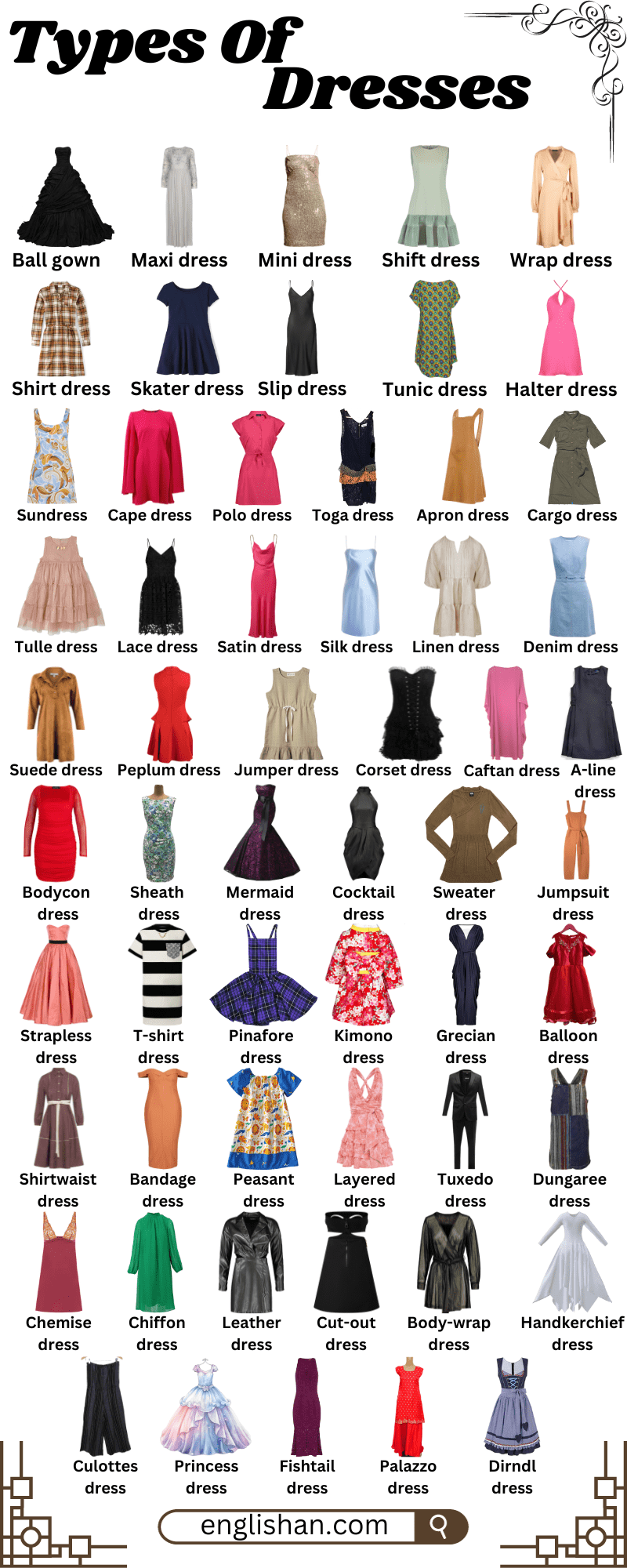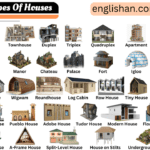Dresses are a big part of women’s fashion. This guide will tell you about different types of dresses for ladies so you can pick the best one for you.
The A-line dress looks like the letter A. Many women like it because it looks good on everyone. The bodycon dress is tight and shows the shape of your body. Some women wear it when they want to look fancy.
Ballgowns are big, fancy dresses. People wear them to special events. The wrap dress goes around you and ties at the side. It’s easy to wear and looks stylish.
Mermaid dresses are tight at the top and wide at the bottom, like a mermaid’s tail. Long dresses that touch the ground are called maxi dresses. They are comfortable and look nice in the summer. Short dresses are called mini dresses. They are fun to wear on a night out.
For work, some women wear a shirt dress. It’s long like a dress but looks like a shirt. The skater dress is tight at the waist and wide at the bottom. It’s good for parties or day events.
So, there are many types of dresses for every woman. No matter what you like, there’s a dress for you. Dresses make you look and feel good, and people search for them a lot online. Every year, new styles come, but these types of dresses always stay popular.
Types of Dresses Names for Ladies
Casual Dresses: Comfortable and versatile, perfect for everyday wear.
Party Dresses: Adorned with sparkles or patterns, ideal for celebrations and special occasions.
Formal Dresses: Elegant and refined, suitable for weddings, galas, or upscale events.
Summer Dresses: Light, airy, and often featuring floral designs, perfect for warm weather.
Winter Dresses: Made from heavier fabrics, providing warmth in colder temperatures.
Maxi Dresses: Flowing and floor-length, exuding grace and sophistication.
Midi Dresses: Ending around the knee or calf, striking a balance between casual and formal.
Mini Dresses: Short and flirty, ideal for a playful and youthful look.
A-Line Dresses: Shaped like the letter “A,” flaring out from the waist for a flattering silhouette.
Sheath Dresses: Fitted and straight, creating a sleek and tailored appearance.
Shift Dresses: Simple and straight, known for their loose and comfortable fit.
Wrap Dresses: Featuring a front closure that wraps around the body, adjustable and flattering.
Shirt Dresses: Inspired by men’s shirts, typically with a button-up front and tailored fit.
Peplum Dresses: Characterized by a flared ruffle or overskirt at the waist, adding flair.
Empire Waist Dresses: High-waisted, with a fitted bodice and a flowing skirt.
Ballgown Dresses: Formal and dramatic, with a fitted bodice and a full, voluminous skirt.
Mermaid Dresses: Fitted through the bodice and hips, then flaring out at the knees.
Trumpet Dresses: Similar to mermaid dresses but with a more gradual flare.
Tea-Length Dresses: Ending between the knee and ankle, offering a vintage charm.
High-Low Dresses: Featuring a hemline that is shorter in the front and longer in the back.
Off-Shoulder Dresses: Exposing the shoulders for a feminine and alluring look.
One-Shoulder Dresses: Single shoulder strap, adding a touch of asymmetry and elegance.
Strapless Dresses: Without shoulder straps, showcasing the neckline and shoulders.
Halter Neck Dresses: Tied around the neck, creating a distinctive neckline.
Spaghetti Strap Dresses: Delicate straps, perfect for a dainty and lightweight appearance.
Fit and Flare Dresses: Fitted at the waist and flaring out at the skirt for a playful look.
Bodycon Dresses: Hugging the body closely, emphasizing curves.
Tiered Dresses: Featuring layers of fabric for added volume and texture.
Tunic Dresses: Loose-fitting and often shorter, suitable for casual settings.
Sweater Dresses: Made of knit fabric, providing warmth and comfort.
Kimono Dresses: Inspired by traditional Japanese robes, characterized by wide sleeves.
Boho Dresses: Embracing a bohemian aesthetic with loose silhouettes and eclectic details.
Kaftan Dresses: Loose and flowing, often with wide sleeves, originating from the Middle East.
Peasant Dresses: Loose-fitting and often with ruffles, evoking a rustic charm.
Corset Dresses: Featuring a corset-style bodice for a structured and fitted look.
Jumper Dresses: Sleeveless and typically worn over a blouse or shirt.
Shirtwaist Dresses: Resembling a button-up shirt with a cinched waist.
Chemise Dresses: Simple and straight, with a loose fit, reminiscent of a nightgown.
T-shirt Dresses: Relaxed and casual, resembling an oversized t-shirt.
Prairie Dresses: Inspired by rural and vintage aesthetics, often with high necklines and ruffles.
Grecian Dresses: Draped and flowing, inspired by ancient Greek attire.
Bandage Dresses: Form-fitting and made of stretchy bands of fabric, creating a body-conscious look.
Slip Dresses: Delicate and lingerie-inspired, often worn as a layering piece.
Salwar Kameez Dresses: Traditional South Asian attire with loose pants and a tunic.
Qipao Dresses: Traditional Chinese dress with a high collar and a fitted form.
Cheongsam Dresses: A form-fitting Chinese dress with a high neck and side slits.
Salwar Suit Dresses: Comprising loose trousers and a tunic, popular in South Asia.
Lehenga Choli Dresses: Traditional Indian attire with a flared skirt, blouse, and dupatta.
Anarkali Dresses: Flowing and voluminous dresses with a fitted bodice, inspired by Mughal fashion.
Palazzo Suit Dresses: Featuring wide-legged pants and a flowing tunic top, offering comfort and style.
You May Also Like
- List of Pet Axolotl Names
- Positive Words List A-Z
- Linking Words in English
- List of Objects Alphabetically




